Recent Storm Damage Posts
Ice Dams Prevention
9/9/2022 (Permalink)
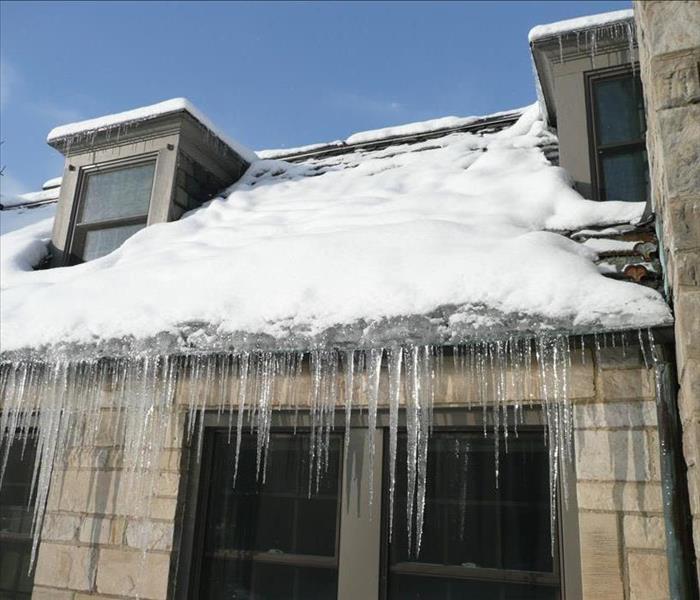 A house that has been affected by an ice dam.
A house that has been affected by an ice dam.
Ice dams occur when heavy snow buildup melts during the day, and then refreezes at night when temperatures drop.
After several days of melting-freezing cycles, the melted water and ice will work up under the shingles. The water will enter the attic and eventually cause damage to the ceilings, wall and contents. In some cases the ice dam could go unnoticed for an extended period of time, and it could cause significant damage to the building and its contents.
You can take steps to reduce the chance of an ice dam forming on your property:
- Thoroughly clean all leaves, sticks and other debris from your home's gutters and down spouts. By doing this it allows melting snow to flow through the gutters and down the spouts.
- If possible, and if it is safe to do so, try to keep the snow on your roof to a minimum. Try using long-handled devices on the market, often called "roof rakes". This will let you pull the snow off the roof from the ground. Keeping the heavy snow off your roof will help reduce the chance for both an ice dam formation and roof failure.
- All winter long, try keeping gutters and down spouts clear of snow and icicles.
- Evaluate the insulation and ventilation in your attic. Good airflow from under the eaves or soffit, along the underside of the roof and out through the roof vents are critical. The insulation is important, as it helps prevents heat loss from the interior of the home. The venting allows the attic air to stay cold enough to prevent or minimize the freeze/thaw. Consult a reputable roofing and/or insulation contractor about these improvements.
Different Types of Water Extraction Pumps
8/24/2022 (Permalink)
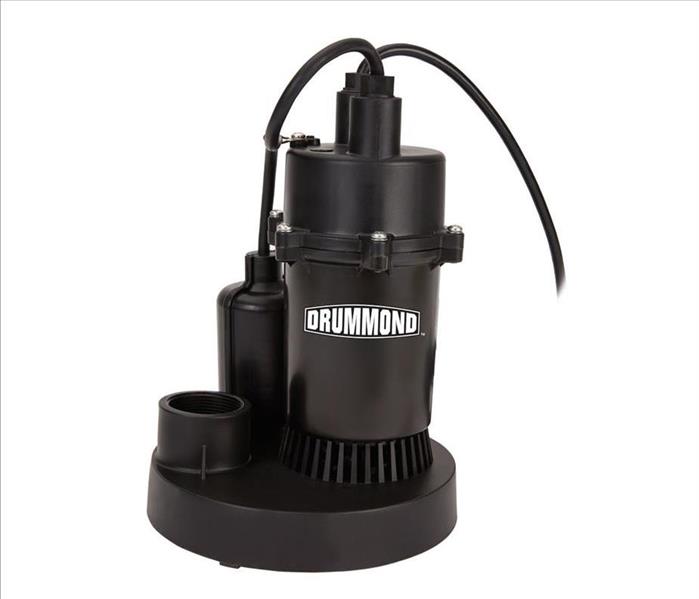 Sump pump
Sump pump
Three Different Types of Pumps That Can Remove Large Amounts of Water
There are several equipment options for extracting water. There are differences between a sump pump, trash sump pump, and truck-mounted pumps. The following details can help determine which of these three pump designs is the best choice for a particular water damage scenario.
1. Sump Pump
A submersible industrial pump is a portable solution for removing water. These pumps draw water at a much faster rate than a truck-mounted pump. Sump pumps can be ideal for crawlspaces, and basements with standing water of two inches or more.
2. Trash Pump
Trash pumps are great for pumping up water in crawlspaces that have a lot of mud or debris. A strainer on the end of the pump ensures that this equipment does not suck up debris that is much larger than leaves or twigs.
3. Truck-Mounted Pump
A diesel truck mount is another solution for extracting standing water. This truck relies on industrial hoses to suck up water from any flooded location. They will have a black water tank on board that will transport this water to an appropriate disposal area. These pumps are most commonly used for any type of standing water that is less than two inches deep.
If you run into any type of flooding problems give SERVPRO of Casper a call. We have all the right pumps to get the water out of your home or building.
Tornado Safety
7/1/2022 (Permalink)
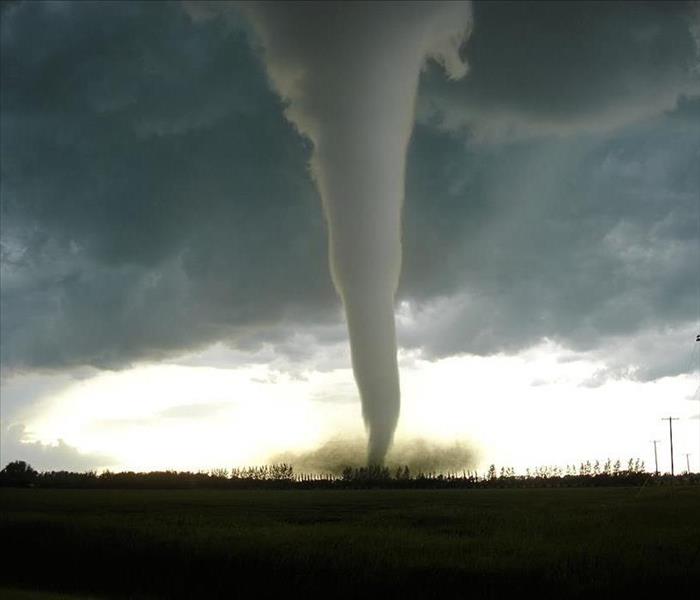 Tornado destruction
Tornado destruction
Tornadoes are not all that common in this part of the state, but they do exist. When a tornado strikes in Wyoming, it is usually in an open space like a field. However, they have touched down in towns before. In the unlikely event of a tornado occurrence near you, here is what to do if you are in a mobile home versus a traditional home:
Traditional Home:
Have a radio for weather alerts and updates nearby, and make sure you have fresh batteries on hand.
Get to the lowest level of your home, such as a basement or storm cellar. If you don't have a basement, go to an inner hallway or a closet, or the bathtub in a bathroom.
Stay away from all windows and glass doorways.
Cover your head and eyes with a blanket or jacket to protect against flying debris and broken glass.
Use stairs only. Do not use an elevator because the power may fail, leaving you trapped inside.
Keep pets on a leash or in a crate close by.
Before going outside, be certain the storm has passed.
Stay in the building you are in. Attempting to out run a tornado to get to a different location is dangerous.
Mobile home:
Mobile homes are not safe during a tornado. You need to evacuate. Even mobile homes equipped with tie-down systems cannot withstand the force of a tornado's winds.
Listen to all local watches and warnings, and take them seriously. If need to, try to get into the basement of a near by home or building.
If no shelter is immediately available, find the lowest-lying area near you and lie flat down in it, covering your head with your hands. Do NOT try to outrun the tornado.
Flood Watch, Warning, Emergency Definitions
4/1/2022 (Permalink)
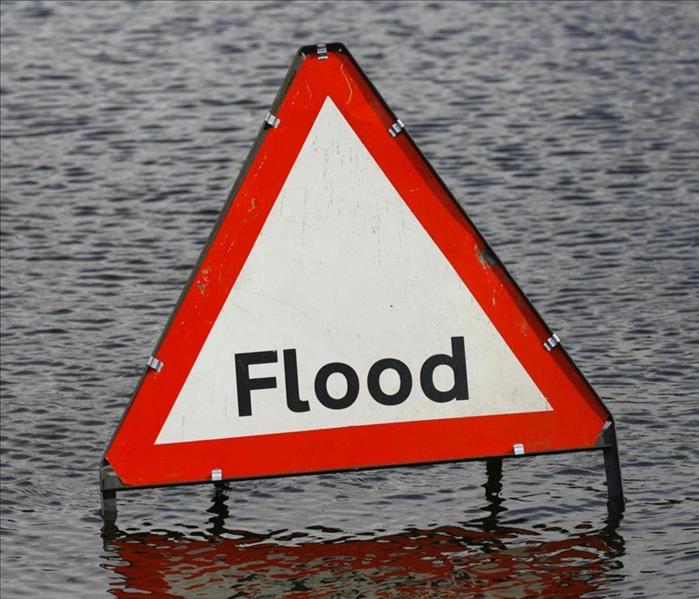 A sign that says flood
A sign that says flood
Spring is here, and so is the rain. There are some years we don’t get a whole lot of rain, and then there are years we deal with intense storms known as microbursts.
A microburst is a localized thunderstorm that is accompanied by significant precipitation. In Wyoming, our soil and drainage systems are not designed to take on a lot of rain at one time, compared to other parts of the country. Because of this, flash flooding may occur. So it is important to understand what a flash flood watch, flash flood warning, and flash flood emergency is. With this knowledge, will better understand how to handle the situation. According to the National Weather Service, this is what they mean.
Flash Flood Watch: When conditions look favorable for flash flooding. A WATCH usually includes several counties. This is the time to start preparing for possible flooding. Consider where you would go if water began to rise.
Flash Flood Warning: When dangerous flash flooding is happening or will happen soon. A WARNING is a smaller, more specific area. It can be issued if the excessive heavy rain is going to cause failure to a dam or levee. You need to act quickly. Flash floods are an imminent threat to you and your family. You could have only seconds to move to higher ground.
Flash Flood Emergency: For the exceedingly rare situations when extremely heavy rain is severe and is a threat to human life, and cause catastrophic damage. Emergency officials are reporting life-threatening water rises, requiring water rescues/evacuations.
Getting Ready for Winter
1/25/2022 (Permalink)
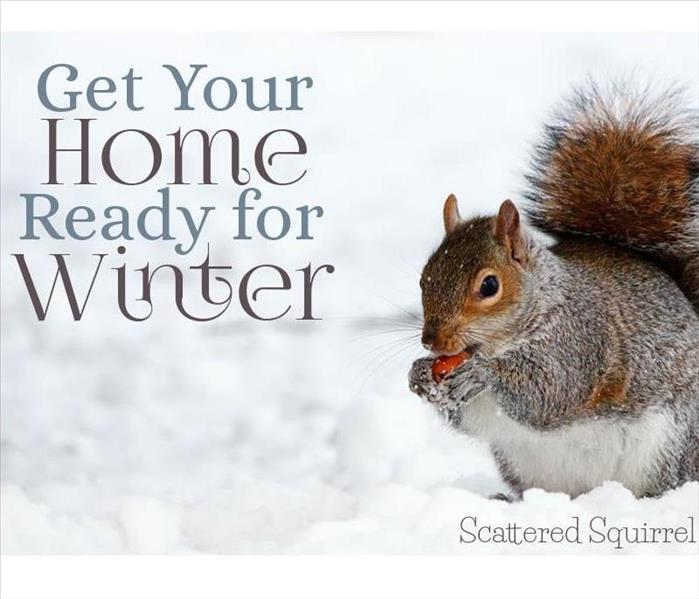 A squirrel getting ready for winter.
A squirrel getting ready for winter.
During the cold months of our Wyoming winter, the low temperatures can wreak havoc on your home. Ice damming on roofs, and pipe breakage from freezing, becomes a greater risk.
Here is a list of things you can do to help get your home ready for the winter:
In the fall, be sure to inspect the exterior of your home for any potential problem areas. Inspect your roof for any missing or damaged shingles. Check your windows for cracks and gaps.
When it is cold, heating your home becomes considerably more expensive. Making your home more energy efficient can help reduce this expense. Sealing door jambs, windows and openings to the home with weather stripping will reduce air drafting in and the heat going out. If you have any gaps on the exterior of your home, be sure to fix those with some caulking.
Clean and inspect your gutters. During the fall, leaves and twigs land and accumulate in the gutters, causing the gutters to lose their draining abilities. With the leaves building up, there is a risk of standing and freezing water.
Before temperatures start to drop, have your heating system checked by a professional. Whether it is a forced-air or boiler heat unit, a system that is running well is almost always more efficient and will save you time and money in the end!
Whether you have a water damage from the freezing temperatures or you need your ducts cleaned, SERVPRO of Casper is here for you anytime.
Vehicle Safety in the Winter and Winter Storms
10/13/2021 (Permalink)
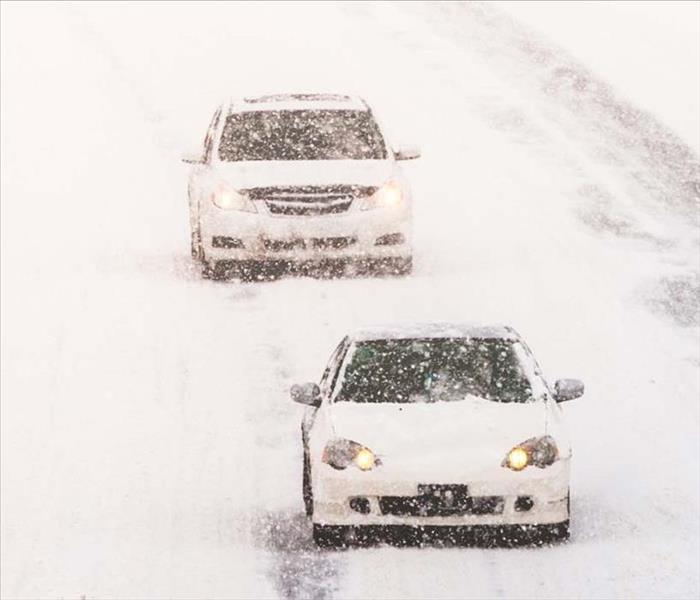 A vehicle on snowy roads.
A vehicle on snowy roads.
Before winter gets here, it is a good idea to start preparing your vehicle. You want to make sure your vehicle is in good working order before the snow starts flying. Here are a few things to check, and fix if needed:
1. It is best to start your inspection no later than November. You may want to start even sooner if you live in a colder environment. You don’t want to be stuck in the snow unprepared.
2. When the temperatures start dropping outside, so does the tire pressure on your vehicle. If the tire pressures drop too much, the performance of your vehicle goes down. When driving on ice and snow, proper air pressure will ensure maximum performance. To see the recommended tire pressure for your vehicle, check the data label inside your vehicle’s driver door, or refer to the owner’s manual.
3. Test your battery. Cold weather reduces the power your battery is capable of producing. At zero degrees F, your battery can only deliver half its normal amperage. If you do not have a battery tester, most auto parts stores will test your battery for you for free. It is also a good idea to keep a pair of jumper cables in your vehicle, in case you unexpectedly experience a weak or dead battery.
4. Check your windshield for cracks or chips. If you have any small chips, have them repaired by a local auto glass company. By having them filled in, this will keep the cracks or chips from spreading. You also want to make sure you have good windshield wiper blades.
5. Inspect your headlights and brake lights. If it is storming, you want to make sure your lights are in working order so you can see, and so people can see you.
6. In winter, it is very important to have an emergency kit in your vehicle. You will want blankets, warm clothes, winter shoes, flashlight, batteries, water, etc.
7. When traveling in winter conditions, always let someone know where you are going, and when you expect to arrive. Then check in when you get to your destination.
By following these tips, you can have a safer winter on the roads.
Hail Storm
4/5/2021 (Permalink)
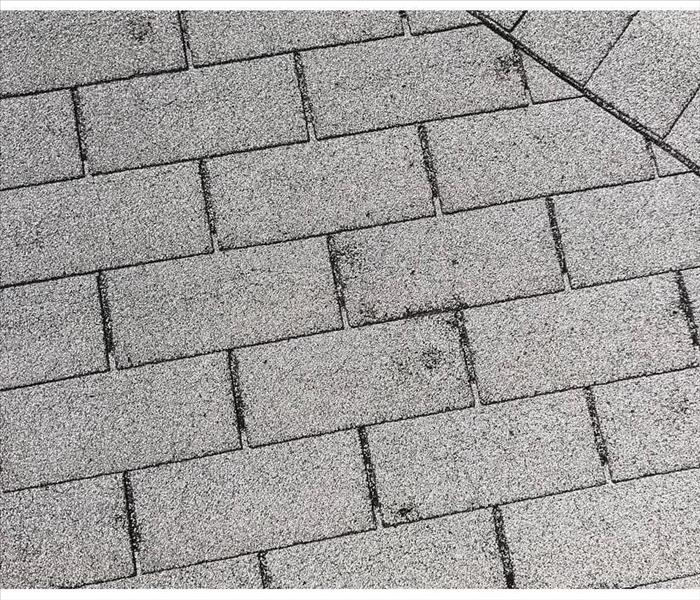 A roof that has a lot of hail damage
A roof that has a lot of hail damage
Even the smallest hailstorm can cause significant damage. The impact from hail can cause denting, cracking, and breaking of a multitude of surfaces. If a home is older or poorly-maintained, the damage from a hailstorm may be more severe. Hail can cause damage to both the interior of your home and the exterior of your home, as well as any exterior attachments.
Exterior Damage – The roof takes the majority of the hit, and depending on the material of the roof it could crack, split, peel, chip, or dent. In some cases windows could break, and if there is a skylight there is a higher risk of them breaking too. Aluminum and wood siding may be dented by side-swept hail. Vinyl siding has an increased risk of breaking under heavy hail impact.
Interior Damage – Depending on the condition of the structure, hail could melt and cause damage to the interior. If you start to see dripping or dark spots in the ceiling drywall, you should look up in the attic to check the insulation to make sure it’s not wet and causing more damage. Then you should look around in your attic and find the location where the water is coming in, so you can tell a roofing contractor. If the hail breaks any windows or skylights, rain and hail can get inside and cause significant damage.
Exterior Attachments – Hail can damage air conditioning units, satellite dishes, antennas, and other attachments on the outside of a home.
If your home sustains interior water damage from a hailstorm, rapid response and drying is important. Give the professionals at SERVPRO of Casper a call anytime, day or night.
Winter driving 1 of 2
3/2/2021 (Permalink)
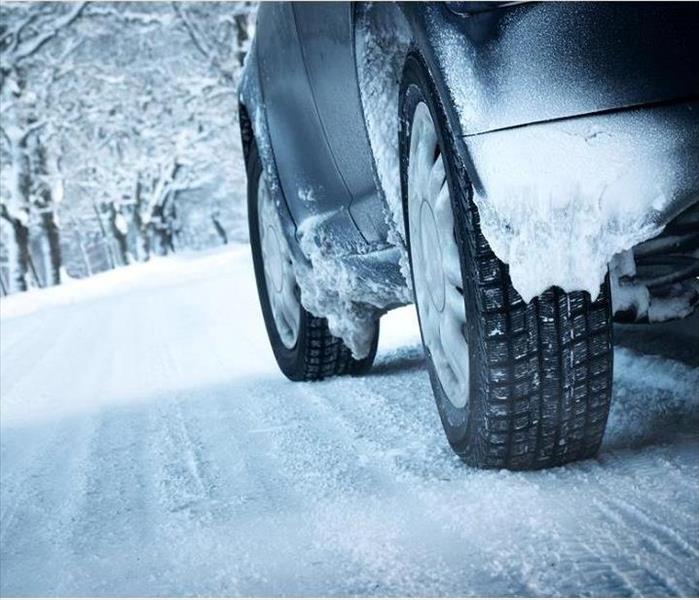 A vehicle driving on snow/icy roads.
A vehicle driving on snow/icy roads.
Winter weather can be unpredictable in Wyoming. When winter storms occur, the condition of local roads and highways can get very bad. While most drivers believe that they are skilled in driving on winter roads, many are not familiar with the fundamentals of driving in slick conditions. Here are some tips on how to drive safely when the roads are slick.
Driving in the snow:
- Stay home, if possible: Simply avoid getting on the road in bad weather, unless it is absolutely necessary.
- Drive slowly: Reduce your speed during slick conditions. It will help maintain traction on snow or ice.
- Accelerate and decelerate slowly: Push down on the throttle and brake pedals slowly to maintain traction, and avoid skids or spin-outs. Allow yourself more time and distance to slow down or stop on slick roads.
- Control your brakes: Even if you have an anti-lock brakes, you should keep your heel planted on the floorboard, and the ball of your foot on the pedal.
- Don’t stop if you can avoid it: If you can go slow up to a red light instead of completely stopping, it is safer. It requires more power to start moving from a full stop versus a slow crawl, and increases your likelihood of breaking traction.
- Don’t “power” up slick hills: If you apply too much throttle on a slick hill, your wheels may start to spin out. Build the inertia on dry land before going up a hill.
Winter driving 2 of 2
3/2/2021 (Permalink)
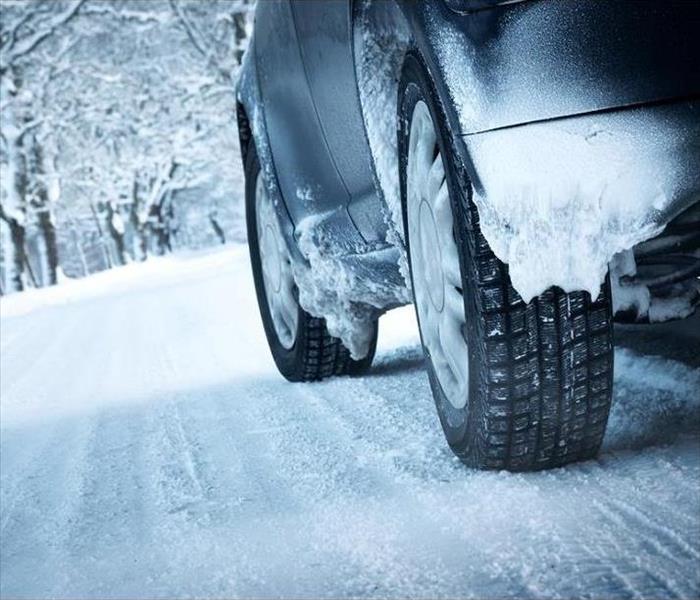 A vehicle driving on snow/icy roads.
A vehicle driving on snow/icy roads.
As you read in the last blog, winters can be unpredictable in Wyoming, and not everyone knows how to drive on bad roads. Here are some tips on how to drive long distances on slick roads, or in unpredictable winter conditions.
- Be Prepared: Make sure your vehicle is in good working order before leaving on long trips.
- Check the Weather: Check the weather reports along your route often for changes.
- Stay Connected: Before leaving on a trip, or when you get to your destination, let someone know.
- Stay with your vehicle: If you get stuck in the snow, don’t leave your vehicle. Your vehicle is a temporary shelter, and it makes it easier to find you.
- Don’t exert yourself: When digging out your vehicle, listen to your body. If you need to rest, do it.
- Be visible: Make sure you have something in your car that is bright and colorful. If your vehicle breaks down, you can tie something bright (such as engineer tape) on the antenna or roll a piece of cloth in the window. If it is night time, turn on your dome light to light up your vehicle so emergency responders can find you.
- Clear the exhaust pipe: Make sure the pipe is not clogged with snow, ice, or mud. If it gets plugged or blocked, there is a risk of carbon monoxide poising.
- Stay warm: Use whatever is available to insulate your body. It is a good idea to pack an extra coat and a couple of blankets during colder months.
- Conserve Fuel: Only run the engine and heater long enough to remove the chill. This will help conserve your fuel, and reduce the risk of carbon monoxide poisoning.
What is a Flood Cut?
1/20/2021 (Permalink)
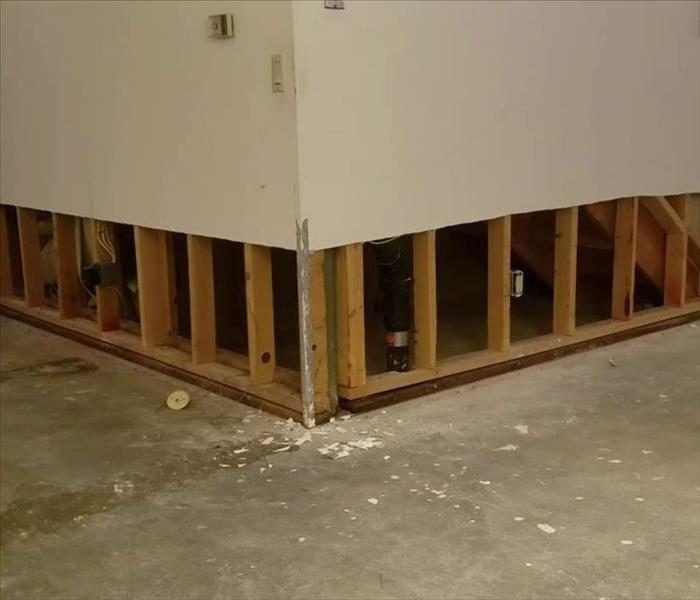 A room that had flood cuts done.
A room that had flood cuts done.
What is a “Flood Cut”?
During water damage emergency services, you may hear the term “flood cut”. A flood cut is the removal of the bottom 12-24 inches of drywall. The amount that is removed depends on how high the water has wicked up the wall, or how much of the drywall is contaminated.
There are many reason flood cuts may be done in a water-damage home or business. These reasons are:
- If the materials have been contaminated by sewage water
- If the materials have been contaminated by outdoor flood water
- If the water damaged sat for an extended number of days
- If suspected microbial growth is present
- If there is a moisture barrier behind the drywall that prevents effective structural drying
After flood cuts are done, once the sub-structure has fully dried, then materials such as insulation and drywall can be replaced.
SERVPRO technicians utilize specialized tools to cut drywall to ensure straight cut lines, and to contain dust created by cutting. We make sure we clean all work areas after we’re done by vacuuming and dusting, and properly dispose of drywall and other materials that may be removed. If appropriate, EPA-registered disinfectant is applied to the affected areas afterward.
Autumn Storms
9/15/2020 (Permalink)
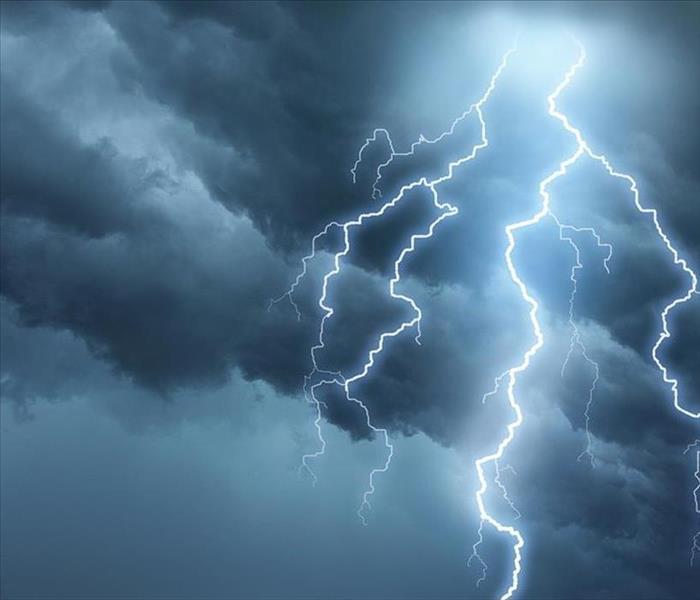 Storm clouds with lightening
Storm clouds with lightening
Autumn storms are right around the corner. The effect of these storms can be good or bad. As much as we love the sound of thunder, the jolt of lightning going through the sky and the smell of rain, there are bad things that can come along with it. Power outages are often a risk associated with storms. It’s good to know what to do in case you lose power, because you never know how long it could be out. It could be out for a matter of seconds, or for several hours. Here are some tips on what how to be prepared, and what to do during a power outage.
Keep flashlights available around your house. Avoid using candles when possible.
Keep the opening of freezers and refrigerators to a minimum. When kept closed, refrigerators can stay cool up to 4hours, and freezers can stay frozen up to 48 hours. If need be, you can put ice in a cooler to keep your food cold.
Watch out for carbon monoxide poisoning. If you are running a generator, it should be used outside and at least 20 feet away from a window or door. Never use a gas stovetop, oven, camp stove, or charcoal grill to heat your home.
If it’s cold in your home, add more layers of clothes and blankets. Don’t use the oven or a grill as a heating source. If it becomes too cold, try to make arrangements to go to another location where heat is available.
Turn off and disconnect any appliances and electronics. The power may surge or spike when it is restored, and that may cause damage to the items.
If you have a sump pump, keep an eye on it so you don’t end up with a flooded basement.
If a storm occurs, the safety of you and your family is of the utmost importance. Be safe out there!
Lightning Safety
6/1/2020 (Permalink)
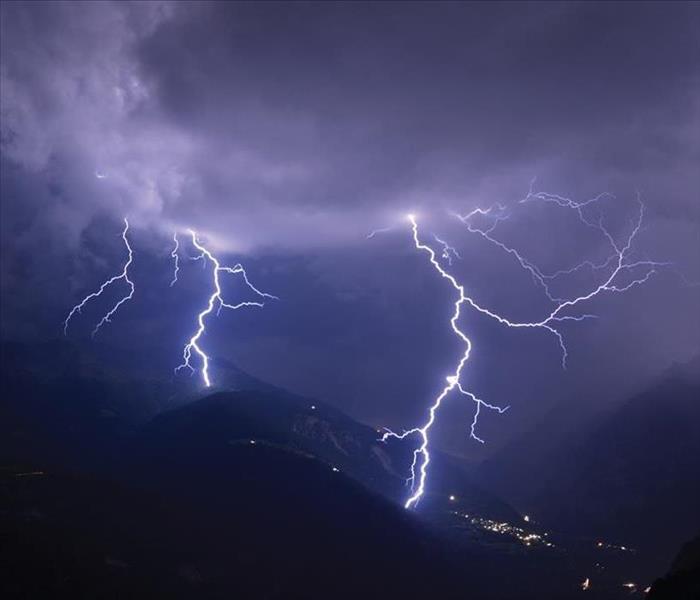 Mountains with streaks of lightning flowing across the sky
Mountains with streaks of lightning flowing across the sky
During the lightning season, you should always be prepared for changing conditions. Everyone is at risk if you have thunder and lightning where you live. You should know what to do if you get caught in a lightning storm.
Lightning and what you need to know:
- NO PLACE outside is safe when thunderstorms are in the area.
- If you hear thunder, lightning is close enough to strike you.
- When you hear thunder, move to a safe shelter. Inside a building is best. If a building is not available, a metal topped vehicle with the windows rolled up is a good alternative.
- Stay in the shelter for at least 30 minutes after you hear the last roll of thunder.
Indoor Lightning Safety:
- Stay off corded phones, computers and other electrical equipment that put you in direct contact with electricity.
- Avoid plumbing, including sinks, baths, and faucets.
- Stay away from doors and windows.
- Stay off of porches and balconies.
- Don’t lie on concrete floors, and don’t lean against concrete walls.
Last Resort Outdoor Risk Reduction Tips:
If you are in a situation where there is no shelter nearby, following these actions will help reduce your risk.
- Immediately get off of a hill, mountain ridges, peaks, or anything that is elevated.
- Never lie flat on the ground.
- Never shelter under a tree.
- Never use a cliff or overhang for shelter.
- Immediately get out of any bodies of water, including ponds, lakes, or ocean.
- Stay away from objects that conduct electricity such as barbed wire fences, power lines, windmills, etc.
Lightning is very beautiful, but also very dangerous. A typical lightning strike yields about 300 million Volts and about 30,000 Amps. A household current is 120 Volts and 15 Amps. There is enough energy in a typical flash to light up a 100-wall incandescent light bulb for about three months. Taking the appropriate safety precautions against lightning can help keep you and your family safe.
Flood Alerts
3/4/2020 (Permalink)
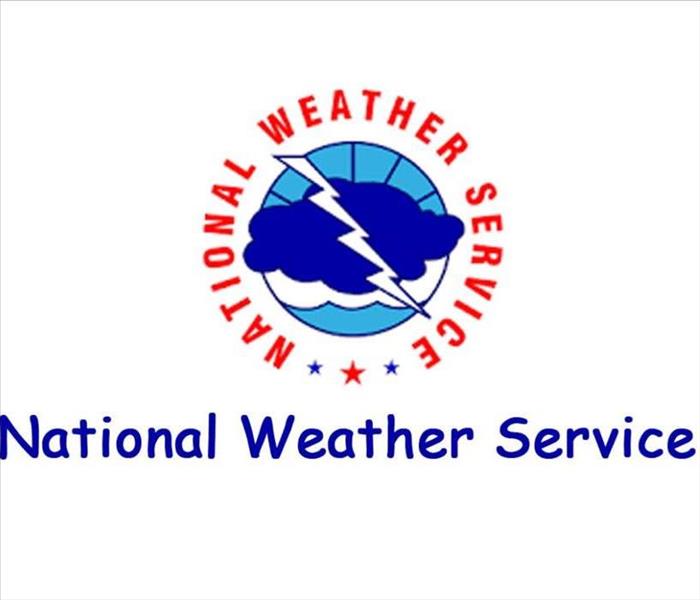 For flood advisories you should look to, The National Weather Service website
For flood advisories you should look to, The National Weather Service website
When it comes to weather alerts, there is always confusion on what flood watch, flood warning, and flood advisories, and flash flood warning mean. It’s good to know the difference so you can take the appropriate course of action for each event. According to the National Weather Service, here is the meaning of each of these alerts.
Flash Flood Warning: Take Action! A flash flood warning is issued when a flash flood is imminent or occurring. If you’re in a flood prone area, move immediately to higher ground. A flash flood is sudden and violent, and it could take anywhere from minutes to hours to develop. It’s even possible to experience a flash flood in areas not immediately receiving rain.
Flood Warning: Take Action! A flood warning is issued when the hazardous weather event is imminent or already happening.
Flood Watch: Be Prepared: A flood watch is issued when conditions are favorable for a specific hazardous weather event to occur. A flood watch is issued when conditions are favorable for flooding. It does not mean that flooding will occur, but it is possible.
Flood Advisory: Be Aware: A flood advisory is issued when a specific weather event that is forecast to occur may become a nuisance. A flood advisory is issued when flooding is not expected to be bad enough to issue a warning. However, it may cause significant inconvenience, and if caution is not exercised, it could lead to situations that may threaten life and/or property.
Frostbite Stages and Treatments
2/14/2020 (Permalink)
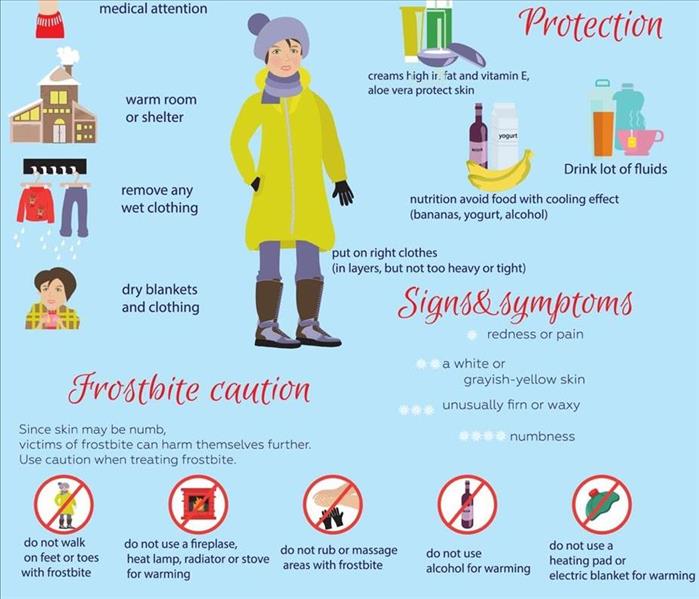 A list of frostbite treatments, protection, signs & symptoms, and frostbite cautions.
A list of frostbite treatments, protection, signs & symptoms, and frostbite cautions.
Frostbite is very dangerous, and should be treated seriously. There are 3 stages of frostbite, and the appropriate treatment for each stage is different. The three different stages are:
Frostnip – Frostnip is a mild form of frostbite. Continued exposure leads to numbness in the affected area. As your skin warms you may feel pain and tingling. This type of frostbite doesn’t permanently damage the skin.
Superficial frostbite – Superficial frostbite appears as reddened skin that turns white or pale. The skin may begin to feel warm; this is a sign of serious skin involvement. If you decide to treat the frostbite with rewarming at this stage, the surface of your skin may appear splotchy. There also may be some stinging, burning, and swelling. Fluid-filled blisters may appear around 12-36hrs after rewarming.
Deep (severe) frostbite – When frostbite progresses, it affects all layers of the skin, including the tissue that lies below. The skin will turn white or a bluish gray, there could be numbness, and loss of sensation of cold, and there will be discomfort. The joints and or muscles may no longer work. Large blisters from 24-48hrs after rewarming. Afterward, the area turns black and hard, because the tissue has died.
When to see a doctor –
If you have any of these symptoms you should seek medical attention:
- Signs of superficial or deep frostbite
- Increased pain, swelling, redness or discharge in the area that was frostbitten
- Fever
- New, unexplained symptoms
If you have been affected by any of this, and are waiting for emergency medical or a doctor’s appointment, there are a few things you can do in the meantime.
- Protecting the affected area from further cold
- Not walking on frostbitten feet
- Reducing pain with ibuprofen
If you suspect hypothermia, get emergency medical help right away. Hypothermia is a condition where your body loses heat faster than it can be produced. Some of the symptoms include:
- Intense shivering
- Slurred speech
- Drowsiness and loss of coordination
Winter Storm Precautions
2/13/2020 (Permalink)
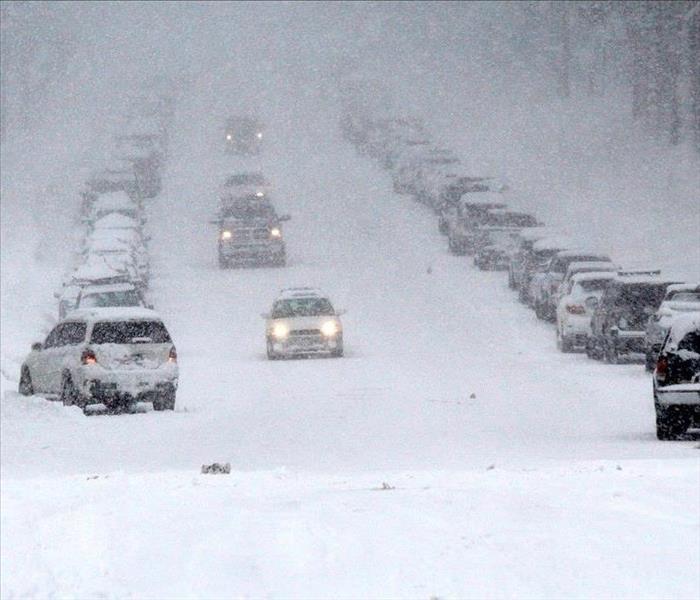 Handling the Winter Storm Months
Handling the Winter Storm Months
Throughout most of the country, the winter season can result in the occasional severe winter storm. Heavy snowfall, strong winds, and extremely cold temperatures can cause entire cities to shut down. Winter storms sometimes last for a few hours, but can extend into a number of days. These severe conditions can cause interruption in heating and power in homes and businesses, as well as knocking out telephone and internet communications. The risk of car accidents, frostbite, and hypothermia can increase in severe weather events. Fortunately, local media (such as TV, radio, and online news sources) can normally give a few days’ notice prior to the arrival of the winter storm.
If you know that a winter storm is approaching, it is best to be prepared as possible:
- Stay off roads
- Stay indoors and dress warmly
- Prepare for power outages
- If you have generators, use them outside only, and away from windows
- Listen to the TV or Radio for emergency updates
- Keep watch for hypothermia and frost bite, if you must go outdoors
- Check on your neighbors, especially if they are older or sick
Please check out my next blog on signs and symptoms of frost bite.
Ice Dam Control
1/22/2020 (Permalink)
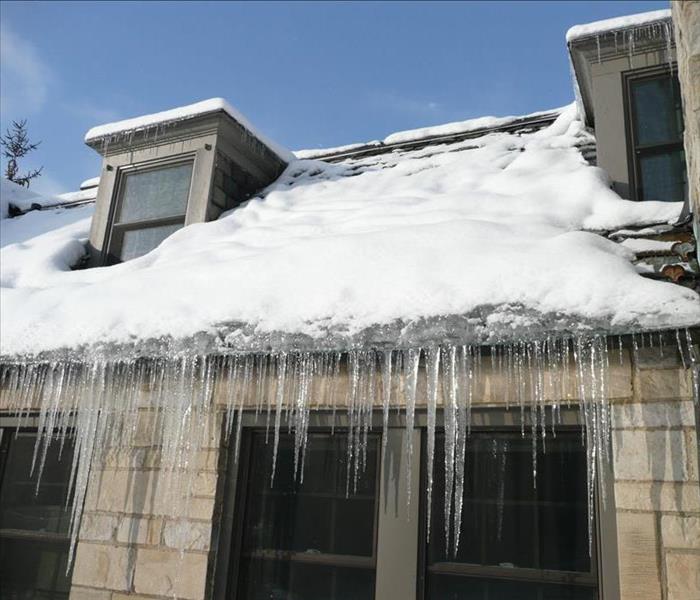 A snowy roof with ice crystals hanging off the gutters.
A snowy roof with ice crystals hanging off the gutters.
You may not see it on your roof, but in the wintertime, ice dams can form and cause serious damage.
An ice dam is a ridge of ice that forms at the edge of a roof and prevents melting snow from draining off the roof. The water that backs up can leak into homes, causing water damage on ceilings, walls, insulation and other materials.
Long term suggestions or immediate action on how to avoid an ice dam:
Short-term action:
- Remove snow from your roof.
- Use a roof rake or push broom. But be careful, it may damage roof materials.
- If you find water flowing into your house creating areas that water can drain off the roof is important.
- Hose down the roof with tap water on a warm day.
- Work upward from the lower edge of the dam.
Long-term action:
- Make the ceiling air tight so no warm, moist air can flow from the house into the attic space.
- After sealing air leakage paths between the house and attic space, consider increasing the ceiling or roof insulation to cut down on heat loss by conduction.
Roof & Attic Ventilation
Natural roof ventilation can help with uniform temperatures. If all other attic issues have been properly corrected, only a small amount of ventilation will be needed to prevent excess warmth in the attic.
If an ice dam has caused water damage within your home, SERVPRO of Casper is always here to help. Feel free to contact us anytime for a damage assessment and consultation.
Tips on how to keep your pipes from freezing
10/17/2019 (Permalink)
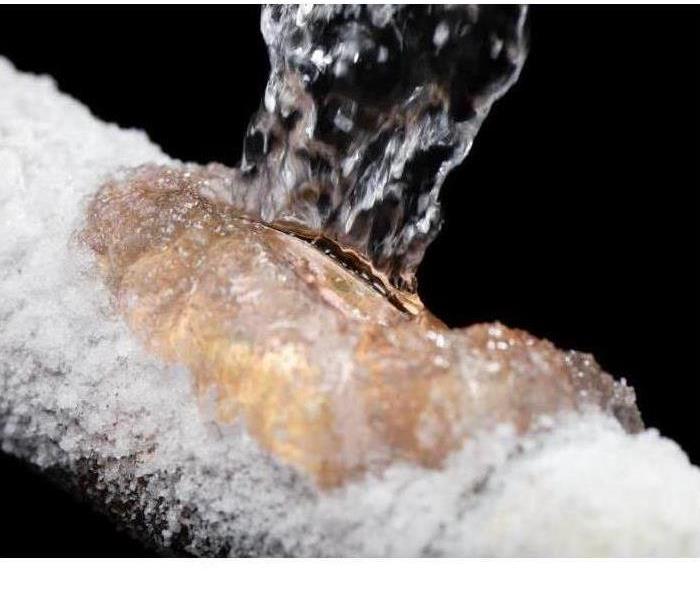 A pipe break that is leaking water.
A pipe break that is leaking water.
With winter right around the corner, there is always a risk of frozen pipes. With some seasonal preparation, you can significantly reduce your risk of plumbing breaks, and the water damage it can cause. Here are a few tips on how to do that.
- Keep garage doors closed if there are water supply lines in the garage.
- In extreme cold conditions, open kitchen and bathroom cabinets to expose the pipes to warmer air. Make sure any harmful cleaners or household chemicals are out of reach for pets and children.
- During freezing temperatures, allow a small amount of water to drizzle from the faucet. This continuous movement of water through the pipes helps keep them from freezing.
- Keep the thermostat at the same temperature at night and during the day. During freezing temperatures, you want to keep the temperature at least 70 degrees.
- If you’re going to be gone during the cold weather, you’ll want to leave the thermostat to at least 55 degrees.
If you happen to experience a water damage because of a frozen pipe this winter season, know that SERVPRO of Casper is here to help.
Safety Driving in a Hail Storm
5/24/2019 (Permalink)
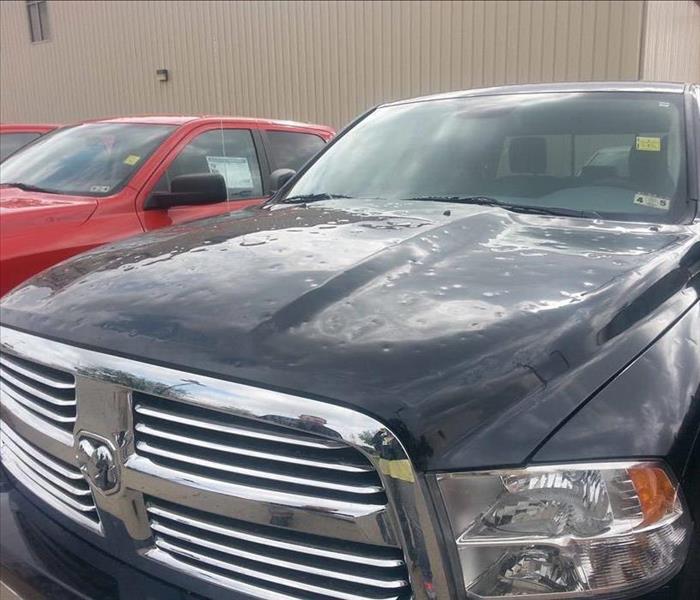 Vehicle damage from a hail storm.
Vehicle damage from a hail storm.
During spring time, rain storms and thunderstorms are a common occurrence. While some of these result in light to moderate rainfall, some may produce hail. Hail storms can cause injuries, and they can be damaging to your property. If you encounter a hail storm, here are some safety tips.
- Hail falls down fast, and can cause injury. If you are in your car when hail begins, it’s best to stay inside your vehicle until the storm passes.
- The speed of your vehicle can amplify the impact of falling hail, and could cause your windshield or any other windows to break. Safely pull your car off the road when hail begins to fall. If possible, parking under a nearby overpass can protect your vehicle from further damage.
- Park your car on an uphill slope, if one is available. Your windshield is designed to stand hard impacts, where the rest of the windows are not.
- When in your car, it is best to be lying down with your back up. Cover yourself with any available blankets or coats to protect yourself from debris in case any windows break.
During any storm it’s important to make sure your radio is on to hear any storm warnings and updates.
Is your area flooding?
5/23/2019 (Permalink)
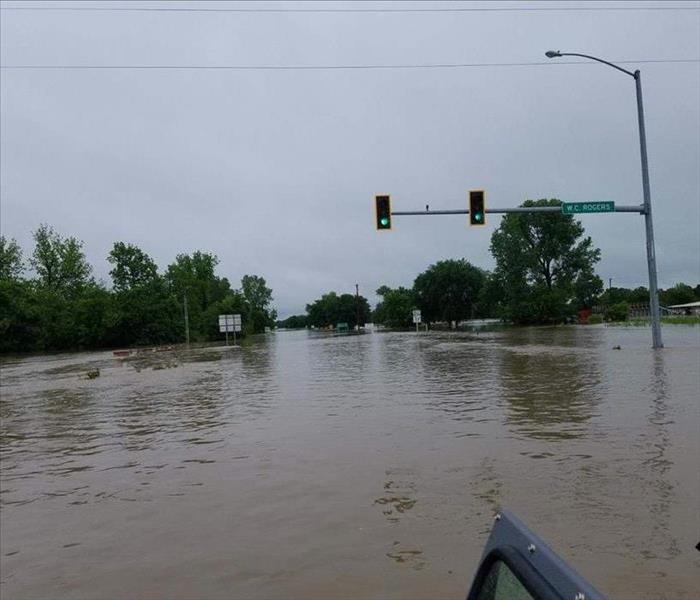 Flooded streets
Flooded streets
Floods are unpredictable, and they can happen in virtually any location you may live in. Just because you haven’t had a flood in the past doesn’t mean it will never happen in your area. It’s very important to be prepared in case the unexpected happens.
Things you need to know:
- Know the flood risk in your neighborhood. Do you live in a flood plain?
- How to prepare your home or property
- How to respond when floodwater comes
- How to recover after a flood
Ways to prepare:
- If your area is flood prone, it is best to have hard-surface flooring instead of carpet in your home
- Prepare an emergency kit
- Prepare a household flood plan
- Keep a list of emergency telephone numbers on display
- Check your insurance policy to make sure your property is covered for flood damage
If flooding is forecast to happen, take time to prepare:
- Place important documents, valuables and vital medical supplies in a waterproof case
- If you go to a different location, make sure your pets are with you. If you cannot take them, make sure you move them to a higher location with plenty of food and water
- Move any electrical appliances, furniture and area rugs to a higher location
Relocating to safer ground:
- Monitor the radio for warnings and advice
- Pack your essential needs: warm clothes, critical medications, valuables, personal papers, and an emergency kit
- Empty fridge and freezers and leave the doors open
- Turn off your gas and water
- Make sure you have your mobile phone with you
- When you leave, make sure you lock your doors
- Do not drive into water of unknown depth
Tornado Safety
4/23/2019 (Permalink)
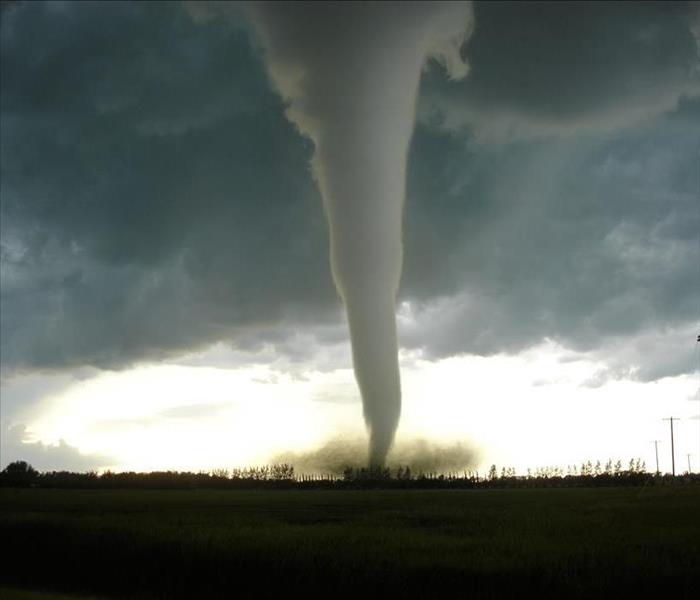 Always be prepared for any kind of storm event.
Always be prepared for any kind of storm event.
Wyoming may not have tornadoes as frequently as areas in the Midwest and the South, but they do still occur. Our wide-open prairies and sparse population result in most tornadoes touching down in unpopulated areas. But there is still a risk of homes and businesses being affected. Because of this possibility, it’s important to know how to handle a potentially dangerous tornado event.
Tip 1: Be prepared
The best way to stay safe during a tornado is to be prepared with:
- Fresh batteries and a battery-operated TV, radio, or internet-enabled device to listen to the latest emergency weather information
- A tornado emergency plan including access to a “safe shelter” for yourself and for people with special needs
- An emergency kit including water, non-perishable food, and medication, and a list of important information, including telephone numbers.
Be sure your children know what a tornado is, and what watches and warnings are.
Tip 2: Stay aware of weather conditions
Pay close attention to changing weather conditions in your area. If you know thunderstorms are expected, stay tuned to local radio and TV stations or a NOAA weather radio for further weather information. Some tornadoes strike rapidly without time for a tornado warning. The following weather signs may mean that a tornado is approaching:
- A dark or green-colored sky
- A large, dark, low-lying cloud
- Large hail or a loud roar that sounds like a freight train
Tip 3: Know where to shelter
Falling and flying debris cause most deaths and injuries during a tornado. Although there is no completely safe place during a tornado, some locations are much safer than others.
- Go to the basement or an inside room without windows on the lowest floor (bathroom, closet, center hallway)
- Avoid windows
- For added protection get under something sturdy (a heavy table or workbench). Cover your body with a blanket, sleeping bag or mattress. Protect your head with anything available.
- Do not stay in a mobile home
RAIN IS ON THE WAY, ARE YOU READY?
3/14/2019 (Permalink)
 Rain is on the way!!
Rain is on the way!!
Before you know it, Spring will be here, and we will get rain. Rain can be a good thing as long as it’s not in your house. Here are some helpful tips to try to keep rain out of your home or building.
- Get your yard ready for the rain by running a metal rake over the tops of shrubs and flowers beds to loosen the soil. This will allow the dirt to better absorb the excess moisture. This should only take a few minutes, but you might prevent rain water from pooling or causing a small flood.
- Close all of your vents and windows. If you forget to do so, you could end up with costly damage. Remember to check rooms that are easily forgotten, such as basements, attics and any rooms you don’t go into on a regular basis.
- Clean your gutters. The leaves aren’t falling yet, but other debris can clog up your gutters. Clean gutters will ensure that excess rain water has proper runoff from your roof.
- Know your roof. Don’t be blindsided by roof damage in the middle of a rain storm. Make sure to get annual inspections and know when your roof is in need of repair.
If water still finds its way into your home or business, don’t worry. We will perform a free inspection and damage assessment, and talk about your options We are always available at 307-235-6558.
Leaky Roof
9/28/2018 (Permalink)
 Leaky roof
Leaky roof
10 Signs That You Need Roof Repair
In the event of heavy raining, your Casper home could be at risk of suffering a water damage that could cost you more than just a new roof. Uncorrected water damage could provide the proper conditions for microbial growth in the home. In small amounts, microbial growth can be remediated with minimal destruction to the home. But if undiscovered for a period of time, it can cause homeowners to be put out of home for the duration of remediation and reconstruction.
Here are some signs if you have a leaky roof:
- There’s a water stain
A water stain may look like a large puddle on the ceiling; it’s often a brownish color. Smaller stains could be a sign of a much bigger leak. If you notice discoloration on your ceiling or walls, take a closer look for mold, moisture, and other telltale signs of a leak.
- Sometimes There’s a Drip
If you see drips, moisture on the walls, or moisture stains but don’t see them often, you may still have a leak in your roof. Even if the leak seems to go away, you still need to get it checked. You may have an ice dam caused by the freezing and thawing of melting snow and ice. The thawed water moves under the shingles and then freezes again, causing intermittent leaks. The rules with any leaks: if you see moisture, investigate, even if it seems to go away. Moisture problems can cause permanent damage.
- There Are Spots on Your Exterior Walls
Everyone once in a while, take a look under your roof line outdoors. If there are water spots under there, you may have trouble where the walls meet the roof. Water spots in this location can point to problems with your flashing.
- Your Walls Are Growing
If you have a mossy or moldy exterior wall, it could be that it’s in a less-than-sunny spot, but it could also point to a problem with your downspouts or gutters. Downspouts and gutters are an important part of your roofing system. When it’s leaking, you may see signs of erosion below the gutters and signs of moisture on the side of your building exterior. Adding gutter covers and gutters heating and repairing sagging gutter can reduce your problems with clogged or icy gutters.
- You See Missing Shingles or See Debris in Your Downspouts
Missing shingles, problems with seams your shingles and other structures such as chimneys could point to trouble. Even though you don’t see a leak inside your house, there could be a slow leak into the attic or crawl space. When you see damage occurring on your roof, ask for an inspection so you know more about the condition of the roof and if there are any leaks.
If you run into a leaky roof, call SERVPRO of Casper. We can come out and do a free inspection inside your home for hidden water damage.
The different types of flooding.
7/9/2018 (Permalink)
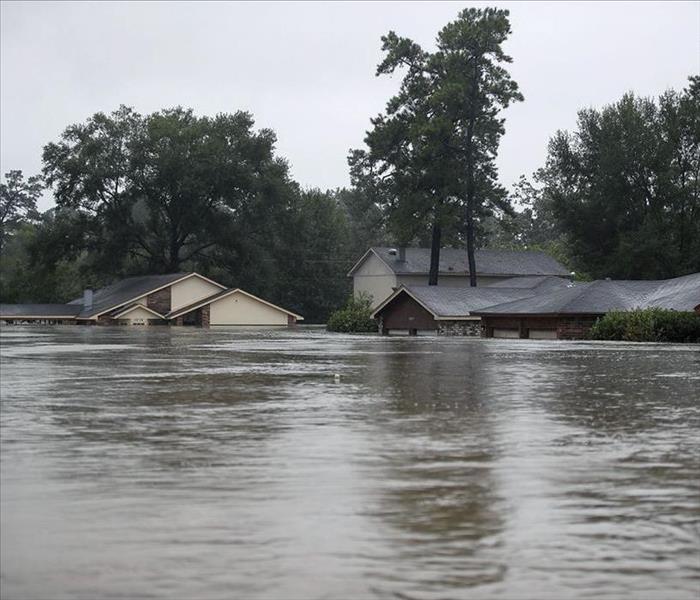 Flooded streets
Flooded streets
Did you know that there is 3 Types of Floods? If you didn’t there is, there is Coastal (Surge Flooding), Fluvial (River Flood), and Pluvial (Surface Flood). Each is unique on how much damage it can cause, and how soon the cleanup can be. Here are the ways the 3 are different from each other.
Coastal (Surge Flooding) -
A coastal flood lies on the coast of a sea, ocean, or other large body of open water. Extreme tidal conditions caused by severe weather such as hurricanes and other storms. These types of storms push water onshore which causes coastal flooding. In this type of flood, water overwhelms low-lying land and often causes devastating loss of life and property.
Coastal Flooding is categorized in three levels:
Minor: A small amount of beach erosion will occur but no major damage is expected.
Moderate: A fair amount of beach erosion will occur as well as damage to some homes and businesses.
Major: Serious threat to life and property. Large-scales beach erosion will occur, numerous roads will be flooded, and many structures will be damaged.
Fluvial (River Flooding) –
River, or riverine flooding, occurs when excessive rainfall over an extended period of time causes a river to exceed its capacity. Snow melt and Ice jams can also cause the river to spill over. The damage from the fiver flood can be widespread as the overflow affects smaller rivers downstream.
There are two main types of riverine flooding:
- Overbank flooding occurs when water rises overflows over the edges of a river or stream. This is the most common and can occur in any size channel. Anywhere from streams, to rivers.
- Flash flooding can be intense, high velocity torrent of water that occurs in an existing river channel with little to no notice. Flash floods are very dangerous, and destructive not only because of the force of the water, but also the hurling debris that is often swept up in the flow.
Pluvial (Surface Flood) -
Surface water flood is caused when heavy rainfall creates a flood event independent of an overflowing water body. You don’t have to be near a body of water to be out of a flood risk, it can even happen in urban areas.
Clouds
4/16/2018 (Permalink)
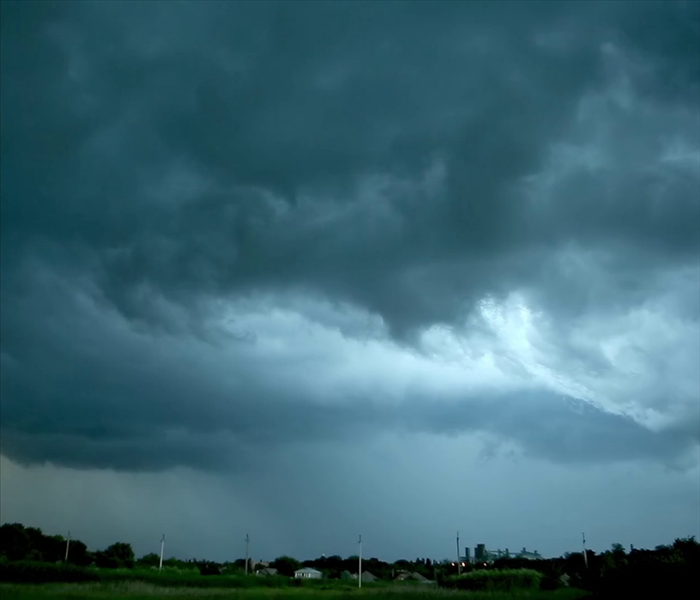 There is all kinds of clouds.
There is all kinds of clouds.
Did you know there are different kinds of clouds that can deliver rain and snow, as well as thunderheads that can produce lightning and heavy precipitation?
Rain/Snow
Stratus clouds are low to mid-level clouds that develop into horizontal, flat formations, and stratus clouds can appear dark and dense or white and puffy. Storm fronts are often preceded or followed by stratus cloud formations carrying precipitation as rain or snow. Because temperatures are warmer closer to Earth and cooler higher up in the atmosphere, low-hanging stratus clouds generally bring rain while higher stratus clouds are associated with snow.
Thunderheads
Cumulus clouds are dense and puffy vertical cloud formations that extend as high as 15,000 meters (50,000 feet) into the atmosphere. Although cumulus clouds are common on sunny, fair-weather days, they earn the moniker of thunderheads because of their tendency to produce thunderstorms. A cumulus cloud becomes a cumulonimbus cloud capable of severe thunderstorms when sufficient heat, updraft and moisture combine in the cloud to produce lightning, thunder and heavy rains.
The next time you see cloud formations in the sky, see if you can figure out what kind it is.
Never to prepared for a storm
3/13/2018 (Permalink)
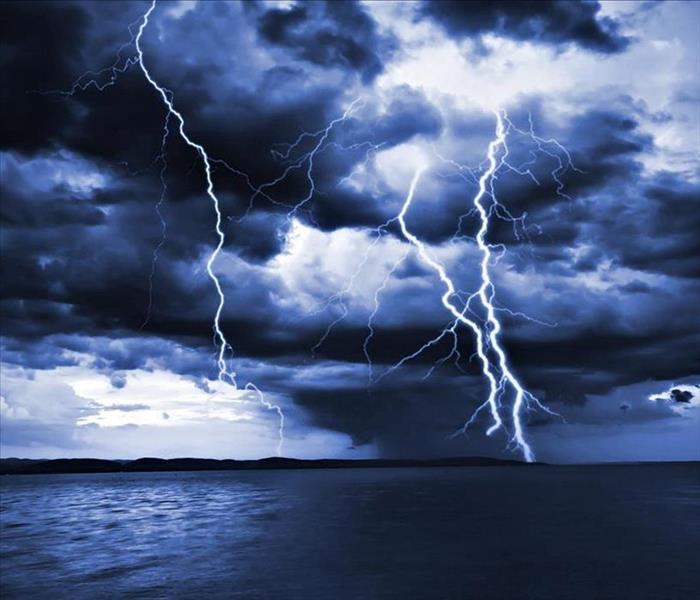 Thunder storm preparedness.
Thunder storm preparedness.
Spring is right around the corner, so it’s a great time to start planning for spring and summer storms. There are many different kinds of storms that can occur during these times of year. Depending on what region of the country you live in, you could potentially be affected by multiple types of storm events. Some areas are more prone to tornadoes or thunderstorms, while coastal areas can be susceptible to hurricanes. You should always be prepared for what could happen to your property, both inside and outside your home. The American Red Cross provides extensive information explaining the different steps you should take to be prepared for a storm.
Here are some tips on what you can do to be prepared:
- Learn about your local community’s emergency warning system for severe
- Discuss thunderstorm safety and lightning safety with all members of your household.
- Pick a safe place in your home for household members to gather during a thunderstorm. This should be away from windows, skylights and glass doors that could be broken by strong winds or hail.
- Make a list of items to bring inside in the event of a severe thunderstorm.
- Make trees and shrubbery more wind resistant by keeping them trimmed and removing damaged branches.
- Protect your animals by ensuring that any outside buildings that house them are protected in the same way as your home.
- Consult your local fire department if you are considering installing lightning rods.
- Get trained in first aid, and learn how to respond to emergencies.
- Put together an emergency preparedness kit.
Preparing for winter storms
1/17/2018 (Permalink)
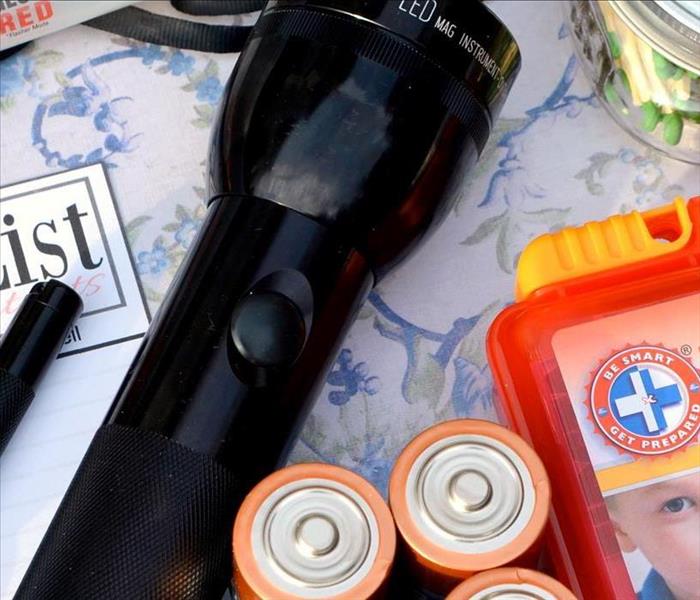 Disaster supply kit
Disaster supply kit
In certain parts of the United States, you have to be prepared for the conditions that come with winter. Conditions can change rapidly, and become hazardous with little to no warning. You should always be prepared whether you’re at home or driving on the roads. A lot of people don’t realize that when you’re at home, there are still risks associated with cold, snowy conditions. If your electricity goes out during a storm, you may run the risk of freezing.
A major winter storm can last for several days, and in some cases, it can have high winds with it. Strong winds and high humidity can create a lower wind chill factor, increasing the risk of frostbite to exposed skin. Winter storms can make driving and walking hazardous. Always listen to the radio and tv for the latest forecast. You should also visit the Wyoming Department of Transportation’s travel information site, at http://www.wyoroad.info , before doing any traveling.
Here are some tips on how to be prepared for a winter storm:
Before a winter storm:
- Have a disaster plan.
- Prepare a disaster supplies kit for your home and car. Include a first aid kit, canned food with opener, bottled water, battery-operated radio, extra batteries, flashlight, protective clothing, and blankets, and matches.
- Be aware of changing weather.
During a winter storm:
- Stay indoors and dress warmly.
- Eat regularly. Food provides the body with energy for producing its own heat.
- Drink water. Also, drink warm broth and juices.
- If you must go outside, wear layered clothing, mittens and a hat.
- Watch for signs of hypothermia and frostbite.
- Keep dry. Change wet clothing to prevent the loss of body heat.
- If you must drive, carry a cell phone with a fully-charged battery.
- Let someone know where you’re going, just in case your car gets stuck.
- If you’re car gets stuck, stay with it and wait for help unless help is visible within 100 yards. Use maps and car mats to stay warm.
After a winter storm
- Avoid driving until conditions have improved.
- Avoid overexertion. Heart attacks from shoveling snow are the leading cause of deaths during the winter.
- Check on neighbors to make sure they are okay.
Your friends at SERVPRO of Casper hope you have a safe and warm winter!!!




 24/7 Emergency Service
24/7 Emergency Service

























